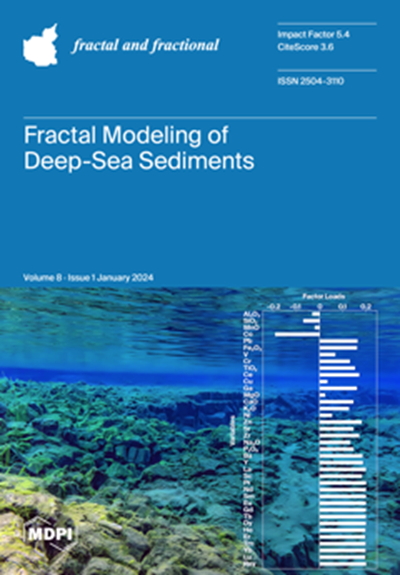Investigation of a Spatio-Temporal Fractal Fractional Coupled Hirota System
IF 3.6
2区 数学
Q1 MATHEMATICS, INTERDISCIPLINARY APPLICATIONS
引用次数: 0
Abstract
This article aims to examine the nonlinear excitations in a coupled Hirota system described by the fractal fractional order derivative. By using the Laplace transform with Adomian decomposition (LADM), the numerical solution for the considered system is derived. It has been shown that the suggested technique offers a systematic and effective method to solve complex nonlinear systems. Employing the Banach contraction theorem, it is confirmed that the LADM leads to a convergent solution. The numerical analysis of the solutions demonstrates the confinement of the carrier wave and the presence of confined wave packets. The dispersion nonlinear parameter reduction equally influences the wave amplitude and spatial width. The localized internal oscillations in the solitary waves decreased the wave collapsing effect at comparatively small dispersion. Furthermore, it is also shown that the amplitude of the solitary wave solution increases by reducing the fractal derivative. It is evident that decreasing the order α modifies the nature of the solitary wave solutions and marginally decreases the amplitude. The numerical and approximation solutions correspond effectively for specific values of time (t). However, when the fractal or fractional derivative is set to one by increasing time, the wave amplitude increases. The absolute error analysis between the obtained series solutions and the accurate solutions are also presented.广田时空分形耦合系统的研究
本文旨在研究由分形分数阶导数描述的耦合 Hirota 系统中的非线性激励。通过使用拉普拉斯变换与阿多米安分解(LADM),得出了所考虑系统的数值解。结果表明,所建议的技术为解决复杂的非线性系统提供了一种系统而有效的方法。利用巴拿赫收缩定理,证实了 LADM 可以得到收敛解。解的数值分析表明了载波的约束和约束波包的存在。色散非线性参数的降低同样影响着波幅和空间宽度。孤波的局部内部振荡降低了相对较小色散时的波坍缩效应。此外,研究还表明,孤波解的振幅会随着分形导数的减小而增大。很明显,阶数α的减小改变了孤波解的性质,并使振幅略有减小。在特定的时间(t)值下,数值解与近似解有效对应。然而,当通过增加时间将分形或分形导数设为 1 时,波幅会增大。此外,还给出了所获得的序列解与精确解之间的绝对误差分析。
本文章由计算机程序翻译,如有差异,请以英文原文为准。
求助全文
约1分钟内获得全文
求助全文
来源期刊

Fractal and Fractional
MATHEMATICS, INTERDISCIPLINARY APPLICATIONS-
CiteScore
4.60
自引率
18.50%
发文量
632
审稿时长
11 weeks
期刊介绍:
Fractal and Fractional is an international, scientific, peer-reviewed, open access journal that focuses on the study of fractals and fractional calculus, as well as their applications across various fields of science and engineering. It is published monthly online by MDPI and offers a cutting-edge platform for research papers, reviews, and short notes in this specialized area. The journal, identified by ISSN 2504-3110, encourages scientists to submit their experimental and theoretical findings in great detail, with no limits on the length of manuscripts to ensure reproducibility. A key objective is to facilitate the publication of detailed research, including experimental procedures and calculations. "Fractal and Fractional" also stands out for its unique offerings: it warmly welcomes manuscripts related to research proposals and innovative ideas, and allows for the deposition of electronic files containing detailed calculations and experimental protocols as supplementary material.
 求助内容:
求助内容: 应助结果提醒方式:
应助结果提醒方式:


